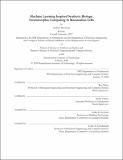Machine learning inspired synthetic biology: neuromorphic computing in mammalian cells
Author(s)
Moorman, Andrew(Andrew Robert)
Download1237125237-MIT.pdf (4.956Mb)
Alternative title
Neuromorphic computing in mammalian cell
Other Contributors
Massachusetts Institute of Technology. Department of Architecture.
Massachusetts Institute of Technology. Department of Electrical Engineering and Computer Science.
Advisor
Ron Weiss and Skylar Tibbits.
Terms of use
Metadata
Show full item recordAbstract
Synthetic biologists seek to collect, refine, and repackage nature so that it's easier to design new and reliable biological systems, typically at the cellular or multicellular level. These redesigned systems are often referred to as "biological circuits," for their ability to perform operations on biomolecular signals, rather than electrical signals, and for their aim to behave as predictably and modularly as would integrated circuits in a computer. In natural and synthetic biological systems, the abstraction of these circuits' behaviors to digital computation is often appropriate, especially in decision-making settings wherein the output is selected to coordinate a discrete set of outcomes, e.g. developmental networks or disease-state classication circuits. However, there are challenges in engineering entire genetic systems that mimic digital logic. Biological molecules do not generally exist at only two possible concentrations but vary over an analog range of concentrations, and are ordinarily uncompartmentalized in the cell. As a result, scaling biological circuits which rely on digital logic schemes can prove difficult in practice. Neuromorphic devices represent a promising computing paradigm which aims to reproduce desirable, high-level characteristics inspired by how the brain processes information - features like tunable signal processing and resource ecient scaling. They are a versatile substrate for computation, and, in engineered biological systems, marry the practical benefits of digital and analog signal processing. As the decision-making intelligence of engineered-cell therapies, neuromorphic gene circuits could replace digital logic schemes with a modular and reprogrammable analog template, allowing for more sophisticated computation using fewer resources. This template could then be adapted either externally or autonomously in long-term single cell medicine. Here, I describe the implementation of in-vivo neuromorphic circuits in human cell culture models as a proof-of-concept for their application to personalized medicine. While biology has long served as inspiration for the artificial intelligence community, this work will help launch a new, interactive relationship between the two fields, in which nature offers more to AI than a helpful metaphor. Synthetic biology provides a rigorous framework to actively probe how learning systems work in living things, closing the loop between traditional machine learning and naturally intelligent systems. This thesis offers a starting point from which to pursue cell therapeutic strategies and multi-step genetic differentiation programs, while exposing the inherent learning capabilities of biology (e.g., self-repair, operation in noisy environments, etc.). Simultaneously, the results included lay groundwork to analyze the role of machine learning in medicine, where its difficult interpretability contradicts the need to guarantee stable, safe, and efficacious therapies. This thesis should not only spur future research in the use of these approaches for personalized medicine, but also broaden the landscape of academics who nd interest in and relevance to its concerns.
Description
Thesis: S.M., Massachusetts Institute of Technology, Department of Architecture, September, February, 2020 Thesis: S.M., Massachusetts Institute of Technology, Department of Electrical Engineering and Computer Science, February, 2020 Cataloged from student-submitted PDF of thesis. Includes bibliographical references (pages 109-117).
Date issued
2020Department
Massachusetts Institute of Technology. Department of Architecture; Massachusetts Institute of Technology. Department of Electrical Engineering and Computer SciencePublisher
Massachusetts Institute of Technology
Keywords
Architecture., Electrical Engineering and Computer Science.